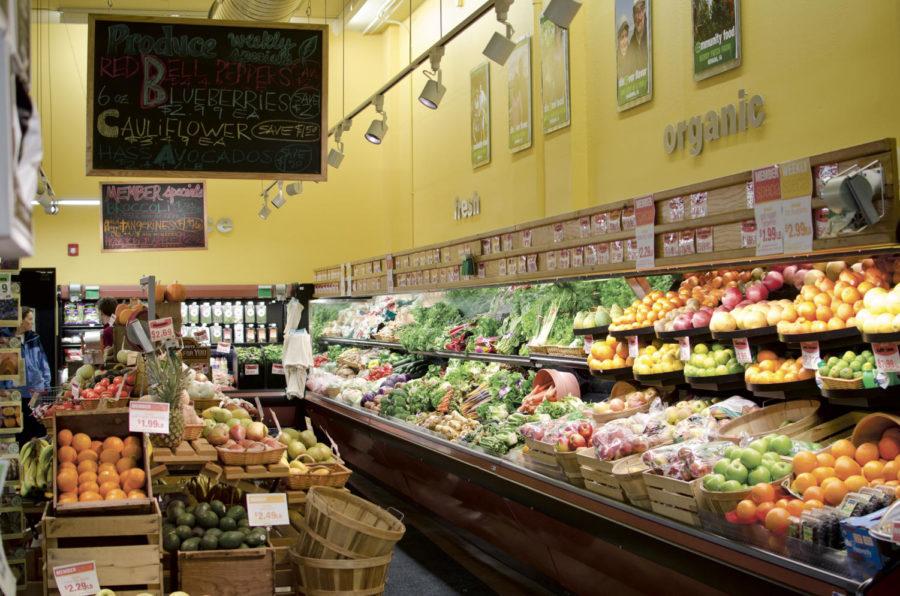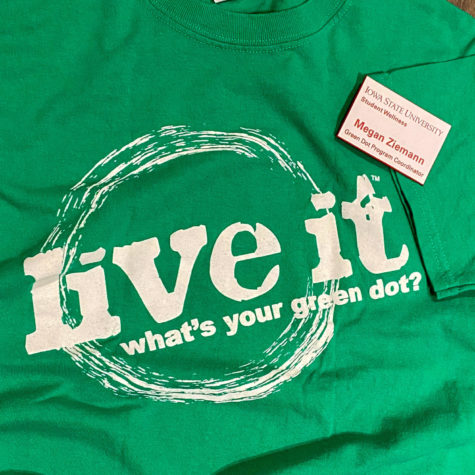Grocery shoppers can be both fiscally responsible, health conscious
Photo: David Derong/Iowa State Daily
Wheatsfield Co-Op, located on the west end of Main Street, offers a wide variety of fresh produce at the entrance to their store.
January 28, 2012
Grocery shopping can be a difficult task. For the fiscally minded, health-conscious individuals, grocery shopping can be a challenge in trying to stay within a budget while buying healthy food. Ruth Litchfield, nutritionist at Iowa State, said there are ways for students to accomplish both.
When searching for the healthiest food, shoppers should stick to the perimeter of the store rather than the inner aisles, Litchfield said.
“Produce, dairy and other perishables are usually at the perimeter of stores. The convenience items are usually in the inner aisle,” she said. “As much of the cart you can fill from the perimeter rather than from the inner aisles the better.”
Shoppers who venture into the inner aisles should look at the very top and very bottom shelves.
“The shelves at eye-level are where the stores put the items they are trying to market more heavily,” Litchfield said. “These items tend to not be the healthiest.”
Shopping on a full stomach and with a pre-made list will help shoppers stay healthy and within budget, Litchfield said. She also recommended that people shop alone.
“Don’t take a friend, spouse or child,” she said. “When you shop alone, you stick to better choices from both a financial and health standpoint.”
Litchfield said a major nutrition-related problem today is that Americans are not eating enough fruits and vegetables. She said only about one in five Americans consume enough fruits and vegetables.
“I look for fruits and whole-grain breads and cereals,” said Jordan Delzell, sophomore in apparel, merchandising and design. “I also buy packages of veggies — just easy, fast, healthy choices.”
Contrary to what some believe, fruits and vegetables do not have to be fresh to be healthy, Litchfield said. She advised that people shop around to see what fits within their budget.
“If the price is right, then buy fresh. But, the second choice is frozen,” she said. “Buying canned vegetables can be very economical. Just make sure it doesn’t have too much sodium and at least drain the liquid.”
More than half of Americans consume too much sodium, Litchfield said. According to the Centers for Disease Control and Prevention, the recommended adequate daily intake level of sodium for an adult is 1,500 mg. However, the average person age 2 and up consumes 3,436 mg of sodium per day, the CDC reported.
The CDC warned that too much sodium raises blood pressure, which increases a person’s risk for heart disease and stroke, the nation’s first and third leading causes of death.
Litchfield said items that shoppers can buy at room temperature and eat right away are usually high in sodium. These nonperishable items are usually in the inner aisles of grocery stores.
“Don’t fill your cart with everything from inner aisles,” Litchfield said.
Shoppers should also choose whole grains over refined grains, Litchfield said.
According to Mayo Clinic’s website, whole grains are unrefined grains that have not had their bran and germ removed, meaning they are a better source for fiber and many other nutrients. Whole grains include brown rice, popcorn and whole-grain bread.
Refined grains have had their bran and germ stripped out and given a finer texture that extends their shelf life while removing many essential nutrients, the Mayo Clinic stated on its website. Refined grains include white rice, white bread and many types of cereal, crackers, pastries and desserts.
“Instead of white rice, use brown rice. Instead of traditional pasta, use whole wheat,” Litchfield said.
The U.S. Department of Agriculture recently updated its seafood recommendation from 3.5 ounces of seafood per week to 8 ounces of seafood per week. This increase came after research showing that omega-3 fatty acids in seafood can help with heart health and aging issues.
“People need to start thinking of creative ways to fit fish and seafood in their diets on a regular basis,” Litchfield said.
Being both fiscally responsible and healthy is possible when grocery shopping, Litchfield said. It just takes knowing what to look for and some practice.

















